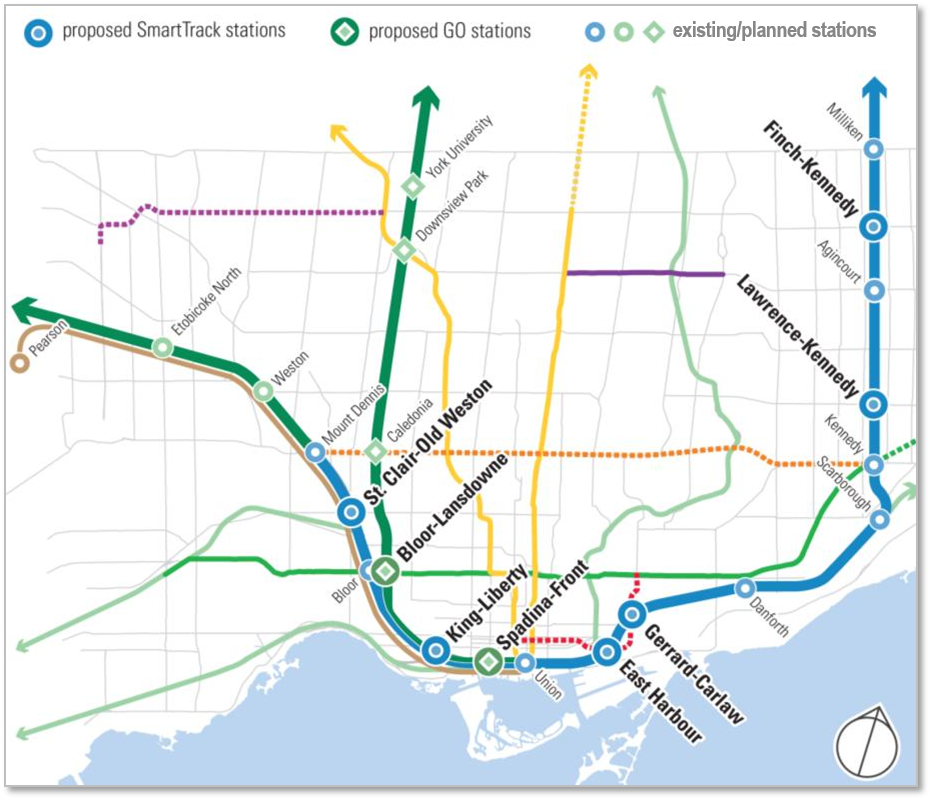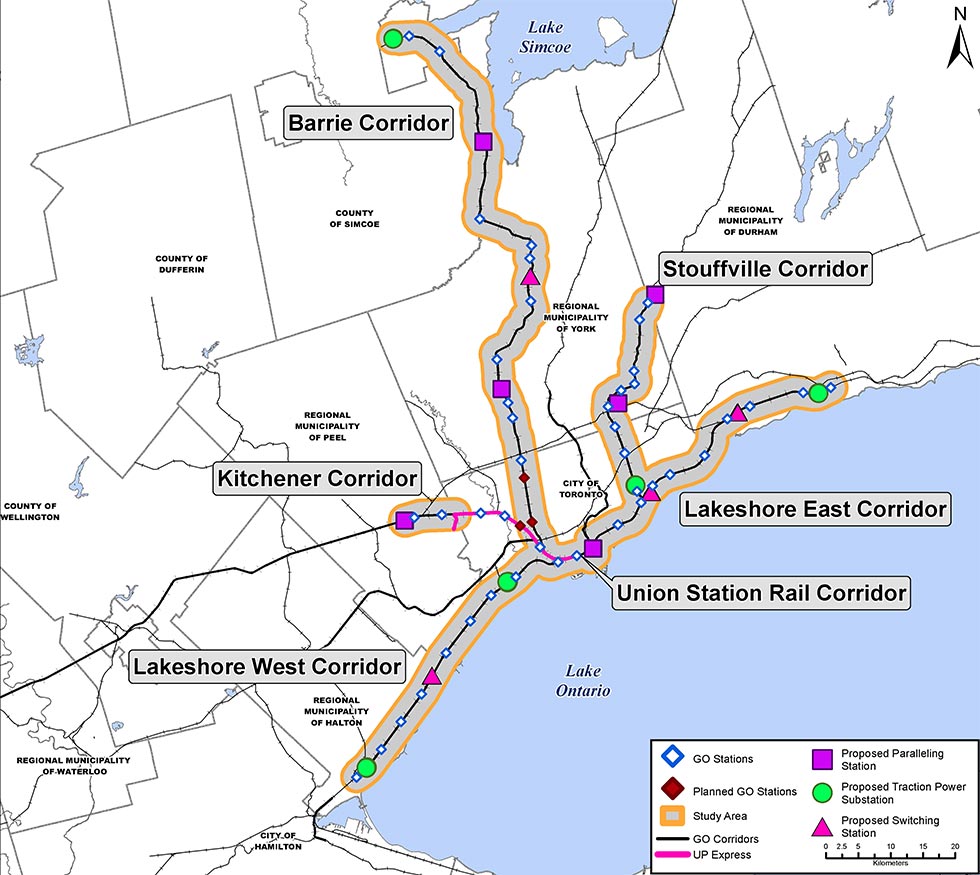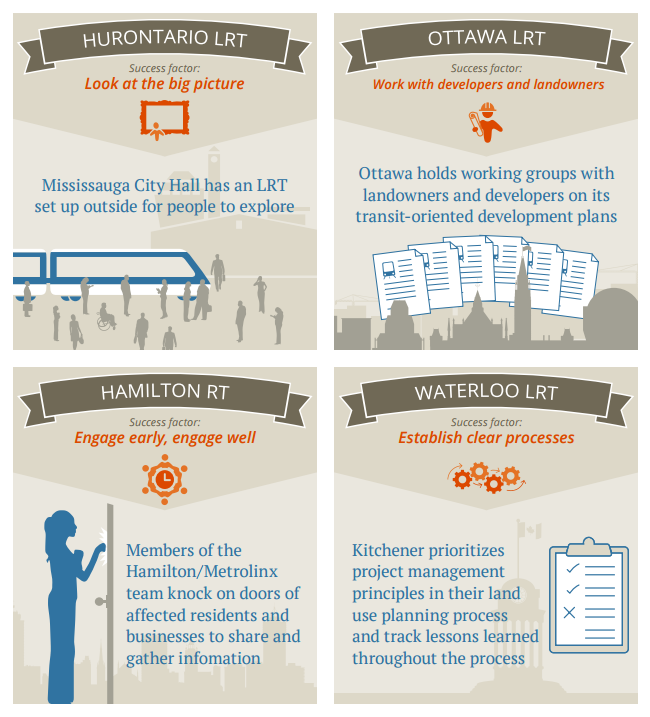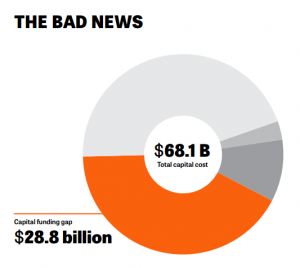There’s a lot going on in the transit world – today we wanted to send an update on what we’re up to, and what’s going on around our region.
See below for updates on these topics:
- Light Rail Projects in Ontario
- Subway Projects
- SmartTrack and GO Regional Express Rail
- CodeRedTO and Allies
- Upcoming Events
Light Rail Projects in Ontario
Eglinton Crosstown LRT (Line 5)
Construction continues along Eglinton with tunneling on schedule and station construction getting closer. Major road traffic impacts will intensify over the next four years, which is common to all tunneled transit projects. Major extensions to the Crosstown have been proposed in 2016, including completing the original line to Pearson Airport in the west, and extending east from Kennedy station up to UTSC. These two extensions are not yet approved and funded, but appear to have significant political support. You can stay up to date by following @CrosstownTO on Twitter or at the link below.
Learn more
The Finch West LRT (Line 6)
Preparations and procurement continue with completion of the Environmental Assessment for the Maintenance and Storage Facility (MSF) required for the light rail vehicles (LRVs) that will bring faster, higher-capacity, and more predictable transit to northern Etobicoke. Construction is expected to begin in 2017, with the line opening in 2021. You can stay up to date by following @finchwestLRT on Twitter or at the link below.
Learn more
The Sheppard East LRT
This project began construction in 2009 (to open in 2013) but was put on hiatus in 2010 by the provincial and municipal governments, and has not resumed construction. The provincial government stated in 2015 that construction would resume after the Finch West LRT opens, in 2021 at the earliest, with the line opening in 2025 at the earliest. Several members of Toronto City Council and MPPs at Queen’s Park continue to push against this project, and recent maps from city staff now omit the term “LRT” when mentioning Sheppard East Rapid Transit.
Mississauga’s Hurontario LRT was truncated in 2015 due to Brampton City Council’s vote to reject the fully-funded provincial project. The project is currently planned and approved to stretch from the Port Credit GO station to the corner of Hurontario and Steeles. This remains an active topic of advocacy and debate in the Brampton community.
Learn more
Hamilton’s LRT will run from McMaster University to the Queenston Traffic Circle with full funding from the provincial government, and continues its planning process, with procurement beginning in 2017, and construction in 2019.
Learn more
Kitchener-Waterloo’s iON LRT continues major construction, with its partner Bus Rapid Transit (BRT) line reaching Cambridge residents and businesses (to be upgraded to LRT in future). Operations are expected to begin in 2017 – the first modern light rail line in Ontario!
Learn more
Ottawa’s Confederation Line LRT upgrade to its existing east-west BRT Transitway continues tunnel and station excavation and construction, and begins track construction this year. Operations are expected to begin in 2018.
Learn more
Heavy Rail Projects in Toronto
The Scarborough Subway Extension continues to evolve, with the Chief Planner’s office developing a modified plan which includes a subway connection from Kennedy Station to Scarborough Town Centre, but adds a new extension to the Eglinton Crosstown (Line 5) along Eglinton eastward to Kingston Road, then north toward the University of Toronto Scarborough Campus (UTSC). This addition would bring new rapid transit to southeast Scarborough and UTSC, which have never had approved and funded projects for their area in recent history.
CodeRedTO is participating in this project’s “Stakeholder Advisory Group” to contribute to the quality and effectiveness of this plan. It is fully funded but is not expected to open until the mid-2020’s at the earliest.
Seven different public meetings are being held February 16 to March 22 to discuss the project and hear from residents and businesses about their preferences. Learn more
The Relief Subway Line continues the planning process of corridor evaluation and future station location evaluation, with the recommended route exiting downtown near City Hall, then heading east to Queen and Broadview, then northeast toward Pape Station. This project has been proposed multiple times since the 1980’s as the subway network has become more congested, but has no committed funding. Completing the planning process now allows a faster start in future once funding has been identified.
CodeRedTO is participating in this project’s “Stakeholder Advisory Group” to contribute to the quality and effectiveness of this future line. This is considered a high priority expansion project, but no funding has been committed by the city, province, or federal government for it yet. Once fully funded, it could open approximately in 12-15 years.
Similar to the Scarborough project, seven different public meetings are being held February 16 to March 22 to discuss this project and hear from residents and businesses and community groups about their preferences and needs. Learn more
SmartTrack and GO Regional Express Rail: The original SmartTrack proposal from 2014 has been modified significantly as it moved from campaign idea to professionally-studied concept.
The western connection along Eglinton West to the Airport Corporate Centre (not the airport itself) is no longer seen as appropriate given technical and financial difficulties, and has been replaced with a proposal to extend the Eglinton Crosstown LRT (Line 5), which was part of the original Crosstown proposal and in fact already has a completed environmental assessment.
In the east, SmartTrack may terminate at or near Kennedy station in Scarborough, with northward expansion unclear at this time. The other Scarborough proposal mentioned above makes this a busy area to consider!
Similar to the subway projects, seven different public meetings are being held February 16 to March 22 to discuss this project and hear from residents and businesses and community groups about their preferences and needs. Learn more about RER and SmartTrack.
CodeRedTO and Allies
Continuing our work with Move The GTHA, we are contributing to a report on the State of Transit in the GTHA, specifically with regard to The Big Move, the 2008 plan which is now about halfway through its initial project period. Stay tuned in the next few months for this report and other evaluations of how we’re doing as a region and whether we’re catching up to where we need to be.
We are also participating in a project to support refugees coming to Toronto in accessing the TTC, with the help of members of TTCriders and other groups. We have also learned that new residents will receive pre-loaded PRESTO cards from the province to assist in accessing transit.
CodeRedTO is also participating in the Stakeholder Advisory Groups working with the Chief Planner’s office on the subway extension from Kennedy to the STC, and on planning for the future Relief subway line.
Last but certainly not least, CodeRedTO has also been contributing support and funding for local advocates across the GTHA, including some groups listed below. If your organization is working on transit issues please let us know and tell us how we can help!
Here are some other groups involved with transit projects and advocacy across the region:
- TTCriders, at www.ttcriders.ca
- Toronto Relief Line Alliance, at www.relieflinealliance.ca
- Scarborough Transit Action, at scarboroughtransitaction@gmail.com
- Etobicoke’s Northwest Transit Action, through Richard De Gaetano at rdegaetano@socialplanningtoronto.org
- Etobicoke’s Our Place Initiative, through Murray Foster at murray@ourplaceinitiative.com
- Fight Gridlock in Brampton, at www.fightgridlock.ca
- Hamilton LRT at www.hamiltonLRT.ca
- Kitchener-Waterloo Region’s TriTAG at www.tritag.ca
Each group has their own diverse set of opinions and goals, but we are all allies in the overall push for better transit options across Toronto and the GTHA.
Upcoming Events
The City of Toronto and the TTC are holding seven days of separate public meetings on SmartTrack, the Scarborough Subway Extension and the Relief Subway Line between February 16 and March 22, to hear from our communities about their needs and preferences for these projects. Locations and schedule:
http://scarboroughsubwayextension.ca/upcoming-public-meetings.html
Environmental Defence presents Sprawl Brawl: Transit vs Highways, on Thursday February 18th at 6:30pm at the University of Toronto’s Innis Town Hall, just south of the St George subway station. Panelists will include Ryerson’s Cherise Burda, Toronto transit historian Ed Levy, Pamela Blais of Metropole Consultants, and former Deputy Minister of Transportation Carol Layton, and the panel will be moderated by journalist John Lorinc.
Click here for more information and to register
Get involved!
CodeRedTO welcomes volunteers from across the GTHA (not just TO!) to represent our communities at public meetings, contribute to “behind the scenes” planning meetings, create new infographics and messaging for improved transit debates, and more. Get in touch! Also, if you have questions, please email info@coderedto.com at any time. We’ll do our best to help!







